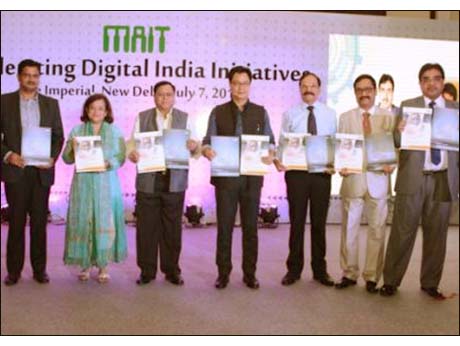
Bangalore, July 9 2016: Manufacturers' Association of Information Technology s (MAIT) think tank -- Digital India Action Group (DIAG) -- has released two studty papers, one on "IoT for Effective Disaster Management" and the other on "Aadhaar Enablement: A Framework for Citizen-Centric Services.
The first white paper aims to create awareness and appreciation about the potential use and applications of IoT for different aspects of disaster management.
The second white paper outlines how deploying an Aadhaar authentication framework, using a facility like e-Sign, governments can move towards a phased improvement in administrative processes, residents' experience of public service delivery and achievement of larger human development objectives.
The white papers were releasesd yesterday in the national capital by unveiled by Kiren Rijiju, Minister of State for Home Affair and by Debjani Ghosh, President, MAIT.
Also present on the occasion were senior Government of India officers Dr. V K Saraswat, Member, NITI Aayog; Lt Gen (Retd.) N C Marwaha Member, National Disaster Management Agency as well as leadership teams from MAIT and the IT industry.
Said Rijiju: "Information Technology has played a key role in changing the face of our country and noteworthy initiatives like Digital India are encouraging us to push the boundaries of innovation. I am happy that industry bodies such as MAIT have taken the lead in helping the government devise proactive policies and plans, and suggest ways to most effectively deploy Information and Communication Technologies to mitigate the effects of disasters and improve effectiveness of service delivery for the government's social welfare schemes."
Added Ms Ghosh: "For the Digital India vision to be successfully realized, it is crucial that we recognize and leverage the potential of emerging technologies such as IoT in disaster management, so as to avoid or minimize the negative impacts of unforeseen events on citizen lives and the economy. IoT is equally relevant for public transportation, government supply chain management, and centrally-managed citizen information repositories such as the one created for Aadhaar, where connected devices can enable efficient, timely and targeted delivery of government healthcare and educational services to citizens."
IoT in Effective Disaster Management
The National Disaster Management Act was passed in December 2005 and envisaged the setting-up of a national, state and district level multi-agency structure headed by the Prime Minister of India, with the Ministry of Home Affairs (MHA) as the nodal ministry. The IoT white paper recommends a 'Seven-Point Action Plan' to shift from a 'relief and recovery' model to 'risk and vulnerability assessment' and address key issues and challenges related to management of natural and man-made disasters in India. In this hyper-connected era, Internet of Things (IoT) plays an important role by interconnecting intelligent devices for the purpose of sharing information. It also provides early warnings through sensor based technologies, thereby creating innovative and effective systems for disaster management.
The white paper also highlights the importance of real-time information management for effective preparation, planning, response and mitigation of disasters. It places emphasis on the IoT as a technology domain, which can pave the way for a radical and pioneering approach to minimize losses caused due to disasters.
Highlights of the IoT White Paper
Impact of Disasters: Some Salient Highlights about India
Issues and Challenges
Recommendations: "The MAIT DIAG Seven-Point Action Plan"
DAIG recommend that the various issues and challenges highlighted above can be addressed through the following 'Seven-Point Action Plan':
Source: MAIT DIAG White Paper "IoT for Effective Disaster Management", June 2016
Aadhaar-Enablement: Foundation for Citizen-Centric Governance
Deploying Aadhaar-enabled systems can transform the relationship between citizens and the government. There is an opportunity for government to engage much more deeply with citizens and significantly enhance the quality of service delivery by using a reliable authentication system.
According to the MAIT DIAG White Paper, Aadhaar generation in the country has crossed 99 crore, which covers 83% of the entire population of the country and more than 95% of the adult population.
Highlights of the Aadhaar Enablement White Paper
Viewed in the context of Aadhaar, the improved connectivity for citizens in all four corners of the country arising out of programs such as Digital India, alternative authentication mechanisms such as the use of Smart Cards have been clearly disrupted. Indeed government departments would be well advised to focus on enabling connectivity for Aadhaar rather than seeking alternative authentication mechanisms such as Smart Cards. Similarly, Aadhaar based e-Sign would replace all token based digital signatures.
Characteristics of Aadhaar-Enabled Citizen Services|
Aadhaar-enablement allows for:
1. Tracking the service delivery process end-to-end,
2. Demand driven, portable service delivery,
3. Access to relevant MIS and empowerment of the beneficiary, and
4. Improved Accountability and Vigilance.
Aadhaar Benefits to User Organizations - Government/Public/Private/Social Sector
Aadhaar allows multi-faceted benefits to user organisations:
a) Aadhaar serves as a Proof of Identity/Proof of Address (PoI/PoA) thereby enhancing inclusion;
b) Aadhaar as a financial address enables Direct Benefits Transfer (DBT);
c) Aadhaar as eKYC serves as a paperless KYC enabler, and
d) Aadhaar reduces leakages in subsidies and payments due to elimination of duplicates, fakes and ghosts.|
The last benefit listed above would be a direct factor of Aadhaar penetration among the base of beneficiaries for a given scheme, that is, highest possible effectiveness would only occur when all target beneficiaries for a given scheme have Aadhaar.
Government Savings: Rs. 27,000 crore ( Rs 270 billion) Saved in Two Years with Aadhaar Enablement
As per recent reports, Government of India estimates a total saving of Rs. 27,000 crore has been realised in the last two years by seeding Aadhaar in various welfare schemes and enabling Direct Benefits Transfer (DBT); this includes government schemes like PAHAL (for LPG cooking gas) and payment of wages under MGNREGS. In 2015-16, fund transfers worth Rs. 61,000 crore were made through DBT to over 30 crore beneficiaries - of which Rs. 25,000 crore was in the form of MGNREGS wages and Rs. 21,000 crore in PAHAL.
Source: MAIT DIAG White Paper "Aadhaar Enablement: A Framework for Citizen-Centric Services", June 2016